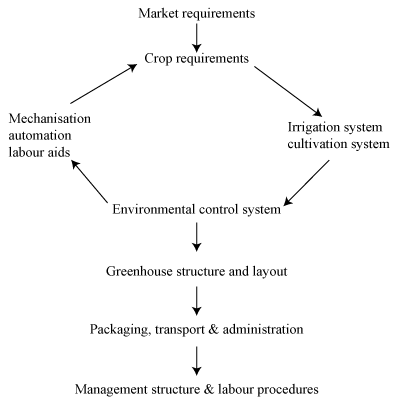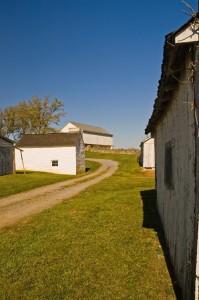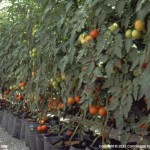5 Important facts about greenhouse design that you should know
The design of a production system consisting of a greenhouse, irrigation system, packing facility, heating system and transport system is an extremely complicated procedure which has to take into account and integrate biological and mechanical systems that work harmoniously together. Not only must this be achieved but the whole system should be flexible, adaptable, versatile, modular in design in order to meet changing market conditions and technological advances made over time. A production system should be planned for the future and not what the grower needs right now. It is built for what the grower needs at that time but the production system should have the potential to provide for changing requirements in the future.
The more flexible, adaptable and versatile a system is, the easier it can be sold later on. Very few growers take this fact into consideration. Another grower will surely not have the same ideals and visions as you have had when you first started the business. If a new grower sees possibilities in your system to fulfil his visions, you are in a better position to bargain a higher price than with an inflexible, un-adaptable system. For any grower, this is a considerably difficult task to accomplish by himself.
A production system should never be designed from the viewpoint of experience, knowledge obtained from other similar production systems or ‘gut’ feeling. The best results are obtained from a logical procedure of design steps, eliminating potential problems through various problem-solving methods. The basic processes involved in developing a total system is described by (Giacomelli and Ting, 1999). Each component in the figure below is discussed briefly

Market requirements.
The first step in considering a greenhouse production system is an analysis of the market that the production system will serve. The market is the most important factor for a grower. If the market or consumers are not happy with the product presented, they will not buy it. Not only must the grower understand the market requirements that he will be serving, but he must also understand the various cycles that his market will go through, the various market forces such as his competition, other substitute and parallel products that are on the market. The market will determine if the product the grower is growing should be packed, vacuum packed or bulk packed. All these factors will have an influence on the design and layout of the final production system.
The crop factory
The area in which a crop is grown should be seen as a factory. Everything that has an influence on the production of the crop should be optimised for maximum output (yield) and minimum running cost. It is therefore important that the crop should not be seen in isolation.
The irrigation system should not be seen in isolation and each of the other systems such as heating, labour etc. should not be seen in isolation. All these aspects of the production system that fall under the roof of the greenhouse should be seen as a whole. Some of the factors that influence the design of an integrated production system are:
- Crop requirements
- Mechanization and automation systems
- Labour procedures
- Irrigation system
- General layout and
- Environmental control of the system
Each crop and even varieties have different temperature and humidity requirements. Although climate outside the greenhouse can make it easier to achieve the correct climate inside the greenhouse, the greenhouse structure and design plays an important role in fine tuning the climate for a specific crop. It also provides some flexibility if the grower decides to change crops. It is evident that in order to achieve the optimum temperature and humidity combination, the greenhouse design will play a pivotal role.
Each of the above aspects should be considered simultaneously. This is probably the most difficult area of the design. Designing a system which is optimised for production does not imply it is labour friendly. Through the design process, a grower or designer is often faced with trade-offs, there never seems to be a system in which all aspects are optimal. Quite often growers tend to increase plant density by narrowing the paths between rows. This makes movement between plants difficult and quite often plants are damaged. Narrow paths also restrict movement during harvesting activities resulting in a loss of productivity.
Labour procedures inside the greenhouse can have a significant effect on the quality of produce harvested, the time it takes to harvest a complete crop and the amount of produce harvested. For instance, tomatoes are not a light crop to harvested. The fruit is packed into crates which have to be transported to the packing area. Each crate can weigh up to 20 kg, depending on crate size. After harvesting the fruit, each crate must not be carried to the packhouse by the same person who did the picking. It should be handled by a different person and preferably loaded onto a small tractor-trailer (such as a Versatrac®). The fewer labourers carry heavy objects the more energy they will have to spend on searching and selecting the correct fruit. It is not their job to carry heavy loads of produce, that should be done mechanically. Providing enough space for transport in the greenhouse reduces the area for production but it will be compensated for the increase in labour productivity and well being. The cost of labour should not be measured in what the are paid, but in the income, they are able to generate for the business.
In the southern hemisphere light is not such a big problem as in the northern hemisphere. It does start to impose on growth when cladding materials are used to cool down or heat up the crop environment. In arid areas, removing excess heat is a major design problem. Adding screens to reduce the harmful effects of sun radiation, decreases the amount of light reaching the plants. During winter heat loss is a problem, by adding more insulating material such as double-layer plastic also reduces the amount of light reaching the plants thus reducing yields. Insulating the greenhouse for heat loss also reduces the effectiveness of the ventilation system. In all areas of the design there are trade-offs. It is up the designer to decide which aspects of the system are more important than the other in terms of the end result which must be achieved.
Greenhouse structure and layout
Once the crop factory and all its requirements have been determined a suitable greenhouse structure and layout can be designed. Greenhouse orientation should be adjusted to prevailing wind direction for optimum ventilation characteristics and sun movement for optimum light interception by the plants. The greenhouse shape can influence the inside air temperature by 3.5-5.5°C during various hours of the day.1)Sethi, V.P.. (2009). On the selection of shape and orientation of a greenhouse for composite climates. International Journal of Sustainable Energy. 28. 45-58.
The topography of the land does play a subtle role. In the southern hemisphere a north facing slope will provide a slight advantage in terms of heat during the winter periods and will also increase light falling into the greenhouse. The subtle factors can increase the yields and quality of the product over a year and during some marginal years can be quite significant in terms of income generated through higher yields.
The greenhouse layout in terms of accessibility is vitally important. There should be easy access into the greenhouse when transporting seedlings, removing dead plant material from the greenhouse and removing the harvested product.
Congested entrances can cause considerable damage to the product due to increased delays of getting the product to either the cooling facility or getting it to the market. The increased time in handling also increases the number of bruised plant material and decreases the amount that is harvested.
Post-harvest management is quite often a neglected area of the production chain and considerable damage can be done to the crop during this period. The flower industry are very well focussed in this area since they work with such a highly perishable product. The layout of the greenhouse should be optimised for the growth area, paths and transport areas.
Packaging, storage, transport and administration
The packaging, storage and administration facilities should be set in one building. Although they are set close to each other, the people involved in packaging, handling fertilizers and chemicals and cleaning of produce should never be able to move freely in the different areas. This is an extremely important point when designing an integrated pack house, storage and administration area. Deliveries should also not enter the area where fertilizers and other chemicals are taken into the production area.
The area within the packing facility should also be designed in order to reduce contamination and mixing of personnel from various packing operations. For instance the personnel responsible for washing of produce should never be allowed to move into the dry area where produce are graded and packed. As soon as these two areas are combined, a significant increase in post harvest decay will be found in the packed produce.
Not only is transport inside the greenhouse important but the transportation routes from the greenhouse to either seedling units, administration buildings, chemical storage etc. should be optimised. Wherever there is high traffic, that route should be made as short as possible and if possible mechanised.
Management structure
The place of the manager is not inside an office with a myriad of computers but inside the greenhouse. He should be at the centre of the factory. It must also be stressed that the ultimate manager is not a person or persons, but the plants growing inside the greenhouse. They will provide the grower with symptoms on which the grower must base his decisions. Plants provide all the information what is wrong with the system. If the humidity is too high or temperature to low or there might be a nutrient imbalance, the plants will provide the information.
Many growers know how to grow a crop. They know the physiology, marketing aspects and how to control the environment inside the greenhouse. The one aspect that many growers neglect is planning. Planning is the thoughtful arrangement of the elements required to make an operation successful. Planning is essential to survival. The planning process helps a grower to foresee possible changes and enables him to be prepared for these changes and to take advantage of a situation.
Management should be strong and effective at all times and in all areas. A poorly designed production system cannot be saved by the best managers and the best-designed system cannot overcome the bad decisions made by poor management (Tognoni, Pardossi, et al, 1999).
References
| ↑1 | Sethi, V.P.. (2009). On the selection of shape and orientation of a greenhouse for composite climates. International Journal of Sustainable Energy. 28. 45-58. |
|---|




